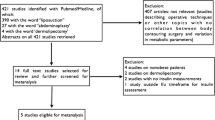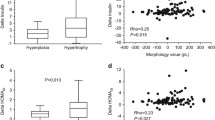Abstract
Adipose tissue is a metabolically active tissue. The hypertrophic fat cells of obese patients produce increased quantities of leptin and tumor necrosis factor-α (TNF-α) and are less sensitive to insulin. This study aimed to determine whether aspirating large amounts of these subcutaneous fat cells by large-volume liposuction (LVL), could change the metabolic profile in 123 obese women. All the patients had a main central body fat distribution (waist–hip ratio, 0.91±0.01) and a body mass index of 32.8 ± 0.8 kg/m). They were studied for 90 days after LVL to determine their changes in insulin sensitivity, resting metabolic rate, serum adipocytokines, and inflammatory marker levels. During 3 months of follow-up evaluation, LVL resulted in a significantly improved insulin sensitivity, resting metabolic rate, serum adipocytokines, and inflammatory marker levels. Such parameters correlate with a decrease in fat mass and waist–hip ratio. Interestingly, no significant changes were seen between the first (21 days) and second (90 days) metabolic determinations after LVL. However, these findings, confirm other preliminary data published previously, and could change the actual role of LVL in the multidisciplinary treatment of obesity.
Similar content being viewed by others
References
Ahima RS, Flier JS: Adipose tissue as an endocrine organ. Trends Endocrinol Metab 11:327, 2000
Ahima RS, Prabakaran D, Mantzoros C, et al.: Role of leptin in the neuroendocrine response to fasting. Nature 382:250, 1996
Baskin ML, Ard J, Franklin F, Allison DB: Prevalence of obesity in the United States. Obes Rev 6:5, 2005
Bastard JP, Maachi M, van Nhieu JT, Jardel C, Bruckert E, Grimaldi A, Robert JJ, Capeau J, Hainque B: Adipose tissue content correlates with resistance to insulin activation of glucose uptake both in vivo and in vitro. J Clin Endocrinol Metab 87:2084–2089, 2002
Borst SE: The role of TNF-alpha in insulin resistance. Endocrine 23:177, 2004
Bouret SG, Simerly RB: Leptin and development of hypothalamic feeding circuits. Endocrinology 145:2521, 2004
Busetto L, Bassetto F, Nolli M: Metabolic effects of liposuction: Yes or no. N Engl J Med 351:1355, 2004
Chlouverakis C, Hojnicki D: Effect of fat cell size on its sensitivity to insulin measured by a new method. Steroids Lipids Res 5:351, 1974
DeFronzo RA, Tobin JD, Andres R: The glucose clamp technique: A method for the quantification of beta cell sensitivity to glucose and of tissue sensitivity of insulin. Am J Physiol 237:E214, 1979
Farooqi IS, Keogh JM, Kamath S, et al: Partial leptin deficiency and human adiposity. Nature 414:34, 2001
Fernandez-Real JM, Lopez-Bermejo A, Casamitjana R, et al.: Novel interactions of adiponectin with the endocrine system and inflammatory parameters. J Clin Endocrinol Metab 88:2714–2718. 2003
Ferrara CM, Goldberg AP: Limited value of the homeostasis model assessment to predict insulin resistance in older men with impaired glucose tolerance. Diabetes Care 24:245, 2001
Friedman JM: Obesity in the new millennium. Nature 404:632, 2000
Giese SY, Bulan EJ, Commons GW, et al.: Improvements in cardiovascular risk profile with large-volume liposuction: A pilot study. Plast Reconstr Surg 108:510, discussion 520, 2001
Giugliano G, Nicoletti G, Grella E, et al.: Effect of liposuction on insulin resistance and vascular inflammatory markers in obese women. Br J Plast Surg 57:190, 2004
Gonzalez-Ortiz M, Robles-Cervantes JA, Cardenas-Camarena L, et al.: The effects of surgically removing subcutaneous fat on the metabolic profile and insulin sensitivity in obese women after large-volume liposuction treatment. Horm Metab Res 34:446, 2002
Halaas JL, Gajiwala KS, Maffei M, Cohen SL, et al.: Weight-reducing effects of the plasma protein encoded by the obese gene. Science 269:543, 1995
Hoffstedt J, Arvidsson E, Sjolin E, Wahlen K, Arner P: Adipose tissue adiponectin production and adiponectin serum concentration in human obesity and insulin resistance. J Clin Endocrinol Metab 89:1391–1396, 2004
Hotamisligil GS, Shargill NS, Spiegelman BM: Adipose expression of tumor necrosis factor-alpha: Direct role in obesity-linked insulin resistance. Science 259:87, 1993
Karnieli E, Barzilai A, Rafaeloff R, et al: Distribution of glucose transporters in membrane fractions isolated from human adipose cells: Relation to cell size. J Clin Invest 78:1051, 1986
Klein S, Fontana L, Young L, et al: Absence of an effect of liposuction on insulin action and risk factors for coronary heart disease. N Engl J Med 350:2549, 2004
Mari A, Pacini G, Brazzale AR, et al.: Comparative evaluation of simple insulin sensitivity methods based on the oral glucose tolerance test. Diabetologia 48:748, 2005
Olefsky JM. Insensitivity of large adipocytes to the antilipolytic effects of insulin. J Lipid Res 18:459, 1977
Olefsky JM: Mechanism of decreased responsiveness of large adipocytes. Endocrinology 100:1169, 1977
Pelleymounter MA, Cullen MJ, Backer MB, et al: Effects of obese gene product on body weight regulation in ob/ob mice. Science 269:540, 1995
Rashid MN, Fuentes F, Touchon RC, Wehner PS: Obesity and the risk for cardiovascular disease. Prev Cardiol 6:42–47, 2003
Robles-Cervantes JA, Yanez-Diaz S, Cardenas-Camarena L: Modification of insulin, glucosa, and cholesterol levels in nonobese women undergoing liposuction. Ann Plast Surg 52:64, 2004
Valsamakis G, McTernan Pg P, Chetty R, Al Daghri N, Field A, Hanif W, Barnett Ah A, Kumar S: Modest weight loss and reduction in waist circumference after medical treatment are associated with favorable changes in serum adipocytokines. Metabolism 53:430–434, 2004
Voros G, Maquoi E, Collen D, Lijnen HR: Influence of membrane-bound tumor necrosis factor (TNF)-alpha on obesity and glucose metabolism. J Thromb Haemost 2:507–513, 2004
Author information
Authors and Affiliations
Corresponding author
Rights and permissions
About this article
Cite this article
D’Andrea, F., Grella, R., Rizzo, M.R. et al. Changing the Metabolic Profile by Large-Volume Liposuction: A Clinical Study Conducted with 123 Obese Women. Aesth Plast Surg 29, 472–478 (2005). https://doi.org/10.1007/s00266-005-0089-x
Published:
Issue Date:
DOI: https://doi.org/10.1007/s00266-005-0089-x




